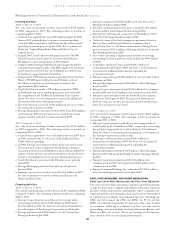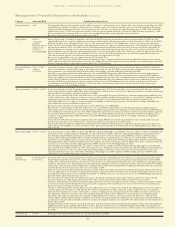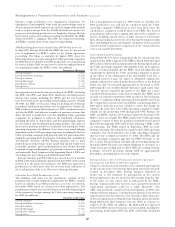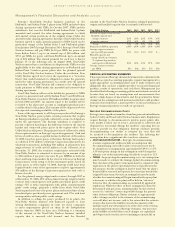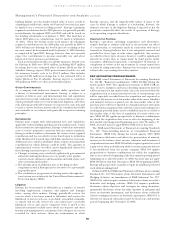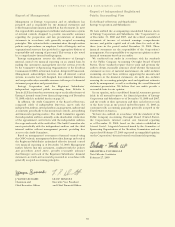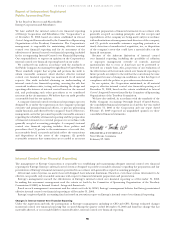Entergy 2008 Annual Report Download - page 47
Download and view the complete annual report
Please find page 47 of the 2008 Entergy annual report below. You can navigate through the pages in the report by either clicking on the pages listed below, or by using the keyword search tool below to find specific information within the annual report.45
ENTERGY CORPORATION AND SUBSIDIARIES 2008
45
Management’s Financial Discussion and Analysis continued
45
In addition to the regulatory scrutiny connected with base rate
proceedings, the Utility operating companies’ fuel and purchased
power costs recovered from customers are subject to regulatory
scrutiny. The Utility operating companies’ significant fuel and
purchased power cost proceedings are described in Note 2 to the
financial statements.
FE D E R A L RE G U L A T I O N
The FERC regulates wholesale rates (including Entergy Utility
intrasystem energy exchanges pursuant to the System Agreement)
and interstate transmission of electricity, as well as rates for System
Energy’s sales of capacity and energy from Grand Gulf to Entergy
Arkansas, Entergy Louisiana, Entergy Mississippi, and Entergy New
Orleans pursuant to the Unit Power Sales Agreement.
System Agreement Proceedings
Production Cost Equalization Proceeding Commenced by the LPSC
The Utility operating companies historically have engaged in the
coordinated planning, construction, and operation of generating
and bulk transmission facilities under the terms of the System
Agreement, which is a rate schedule that has been approved by the
FERC. The LPSC has been pursuing litigation involving the System
Agreement at the FERC. The proceeding includes challenges to the
allocation of costs as defined by the System Agreement and raises
questions of imprudence by the Utility operating companies in
their execution of their obligations under the System Agreement.
In June 2005, the FERC issued a decision in the System Agreement
litigation that had been commenced by the LPSC, and essentially
affirmed its decision in a December 2005 order on rehearing. The
FERC decision concluded, among other things, that:
nThe System Agreement no longer roughly equalizes total
production costs among the Utility operating companies.
nIn order to reach rough production cost equalization, the FERC
will impose a bandwidth remedy by which each company’s
total annual production costs will have to be within +/- 11% of
Entergy System average total annual production costs.
nIn calculating the production costs for this purpose under the
FERC’s order, output from the Vidalia hydroelectric power
plant will not reflect the actual Vidalia price for the year but is
priced at that year’s average price paid by Entergy Louisiana
for the exchange of electric energy under Service Schedule
MSS-3 of the System Agreement, thereby reducing the amount
of Vidalia costs reflected in the comparison of the Utility
operating companies’ total production costs.
nThe remedy ordered by FERC in 2005 required no refunds and
became effective based on calendar year 2006 production costs
and the first potential reallocation payments were made in 2007.
The FERC’s decision reallocates total production costs of the
Utility operating companies whose relative total production costs
expressed as a percentage of Entergy System average production
costs are outside an upper or lower bandwidth. Under the
current circumstances, this will be accomplished by payments
from Utility operating companies whose production costs are
more than 11% below Entergy System average production
costs to Utility operating companies whose production costs
are more than the Entergy System average production cost,
with payments going first to those Utility operating companies
whose total production costs are farthest above the Entergy
System average.
Assessing the potential effects of the FERC’s decision requires
assumptions regarding the future total production cost of each
Utility operating company, which assumptions include the mix of
solid fuel and gas-fired generation available to each company and
the costs of natural gas and purchased power. Entergy Louisiana,
Entergy Gulf States Louisiana, Entergy Texas, and Entergy
Mississippi are more dependent upon gas-fired generation sources
than Entergy Arkansas or Entergy New Orleans. Of these, Entergy
Arkansas is the least dependent upon gas-fired generation sources.
Therefore, increases in natural gas prices likely will increase the
amount by which Entergy Arkansas’ total production costs are
below the Entergy System average production costs.
The LPSC, APSC, MPSC, and the Arkansas Electric Energy
Consumers (AEEC) appealed the FERC’s decision to the United
States Court of Appeals for the D.C. Circuit. Entergy and the City
of New Orleans intervened in the various appeals. The D.C. Circuit
issued its decision in April 2008. The D.C. Circuit affirmed the
FERC’s decision in most respects, but remanded the case to the
FERC for further proceedings and reconsideration of its conclusion
that it was prohibited from ordering refunds and its determination
to implement the bandwidth remedy commencing with calendar
year 2006 production costs (with the first payments/receipts
commencing in June 2007), rather than commencing the remedy
on June 1, 2005. The D.C. Circuit concluded the FERC had failed
so far in the proceeding to offer a reasoned explanation regarding
these issues. On July 17, 2008, the Utility operating companies
filed with FERC a motion proposing additional procedures on the
remanded issues. The proceeding is pending at the FERC.
Entergy’s Utility Operating Companies’ Compliance Filing
In April 2006, the Utility operating companies filed with the FERC
their compliance filing to implement the provisions of the FERC’s
decision. The filing amended the System Agreement to provide for
the calculation of production costs, average production costs, and
payments/receipts among the Utility operating companies to the
extent required to maintain rough production cost equalization
pursuant to the FERC’s decision. The FERC accepted the
compliance filing in November 2006, with limited modifications.
The Utility operating companies filed a revised compliance
plan in December 2006 implementing the provisions of the
FERC’s November order. In accordance with the FERC’s order,
the first payments/receipts were based on calendar year 2006
production costs, with the payments/receipts among the affected
Utility operating companies made in seven monthly installments
commencing in June 2007.
Various parties filed requests for rehearing of the FERC’s order
accepting the compliance filing. Among other things, the LPSC
requested rehearing of the FERC’s decision to have the first payments
commence in June 2007, rather than earlier; to not require interest
on the unpaid balance, and the FERC’s decision with regard to
the re-pricing of energy from the Vidalia hydroelectric project for
purposes of calculating production cost disparities. Various Arkansas
parties requested rehearing of the FERC’s decision (1) to require
payments be made over seven months, rather than 12; (2) on the
application of the +/- 11% bandwidth; and (3) to reject various
accounting allocations proposed by the Utility operating companies.
In April 2007, the FERC denied the requests for rehearing, with
one exception regarding the issue of retrospective refunds. That
issue will be addressed subsequent to the remanded proceeding
involving the interruptible load decision discussed further below
in this section under “Interruptible Load Proceeding.” The LPSC
appealed the decision to the D.C. Circuit Court of Appeals, and
the Utility operating companies and the APSC intervened in that
appeal. The LPSC raised three issues in its appeal: the inclusion
of interruptible loads in the calculation of production costs, the
repricing of energy from the Vidalia hydroelectric project, and
the timing of the implementation of the remedy. Briefing in this
proceeding is scheduled during the first quarter 2009.










